
File photo copy shows Chinese forced labors working for Japan to build the Fengman hydropower station in Jilin of northeast China after the region was illegally occupied by Japanese invaders in 1931. Japan invaded northeast China in 1931 and conducted a full-scale invasion in 1937. By the end of World War II, millions of Chinese forced laborers had been enslaved by Japanese invaders to toil under harsh conditions at mines and factories in northeast China and Japan. Those laborers were under close watch and suffered inhumane treatment. Many of them died from malnutrition, illness, physical abuse and plain murder. (Xinhua/Jiang Lin)
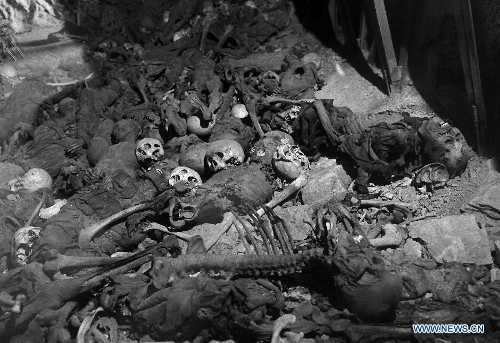
File photo taken on July 9, 2015 shows a coal mine pit cramed with skulls and bones of Chinese forced miners working for Japan during the World War II, at a memorial in Datong, north China's Shanxi Province. Japan invaded northeast China in 1931 and conducted a full-scale invasion in 1937. By the end of World War II, millions of Chinese forced laborers had been enslaved by Japanese invaders to toil under harsh conditions at mines and factories in northeast China and Japan. Those laborers were under close watch and suffered inhumane treatment. Many of them died from malnutrition, illness, physical abuse and plain murder. (Xinhua/Zhan Yan)
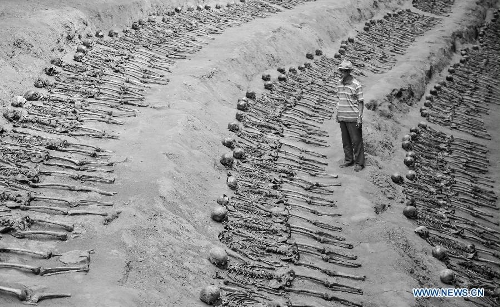
File photo taken on Aug. 28, 2014 shows Sun Yuanxin, who is a surviving forced miner working for Japan during the World War II, looking at the remains of forced miners at a museum of Liaoyuan miners' tomb during Japanese occupation in Liaoyuan, northeast China's Jilin Province. Japan invaded northeast China in 1931 and conducted a full-scale invasion in 1937. By the end of World War II, millions of Chinese forced laborers had been enslaved by Japanese invaders to toil under harsh conditions at mines and factories in northeast China and Japan. Those laborers were under close watch and suffered inhumane treatment. Many of them died from malnutrition, illness, physical abuse and plain murder. (Xinhua/Wang Haofei)
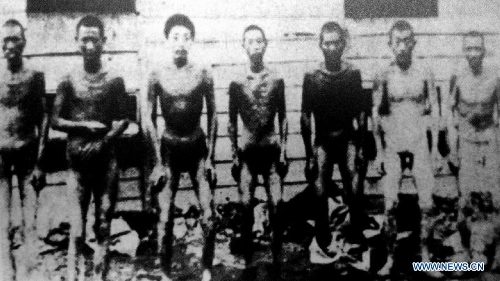
File photo copy shows Chinese forced labors in Hanaoka, Japan. Japan invaded northeast China in 1931 and conducted a full-scale invasion in 1937. By the end of World War II, millions of Chinese forced laborers had been enslaved by Japanese invaders to toil under harsh conditions at mines and factories in northeast China and Japan. Those laborers were under close watch and suffered inhumane treatment. Many of them died from malnutrition, illness, physical abuse and plain murder. (Xinhua)
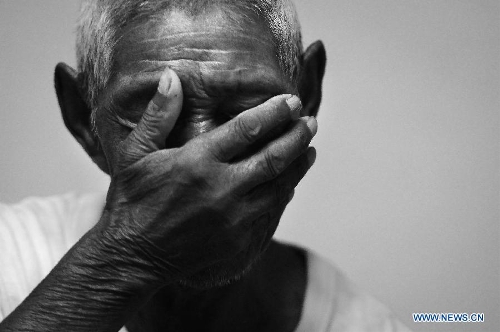
File photo taken on July 26, 2014 shows Chinese Sun Yuanqi weeping while recalling the tribulation as a forced labor working in Japan during World War II, in east China's Shandong Province. Japan invaded northeast China in 1931 and conducted a full-scale invasion in 1937. By the end of World War II, millions of Chinese forced laborers had been enslaved by Japanese invaders to toil under harsh conditions at mines and factories in northeast China and Japan. Those laborers were under close watch and suffered inhumane treatment. Many of them died from malnutrition, illness, physical abuse and plain murder. (Xinhua/Guo Xulei)
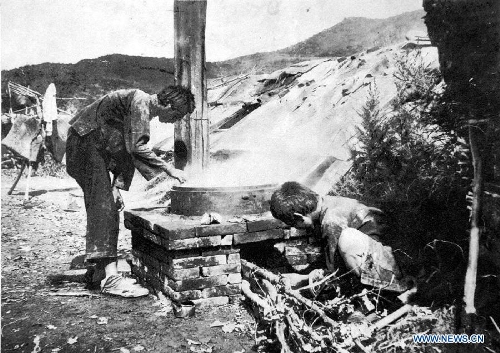
File photo copy shows Chinese forced labors cooking a meal, who were captured by Japanese to build the Fengman hydropower station in Jilin of northeast China after the region was illegally occupied by Japanese invaders in 1931. Japan invaded northeast China in 1931 and conducted a full-scale invasion in 1937. By the end of World War II, millions of Chinese forced laborers had been enslaved by Japanese invaders to toil under harsh conditions at mines and factories in northeast China and Japan. Those laborers were under close watch and suffered inhumane treatment. Many of them died from malnutrition, illness, physical abuse and plain murder. (Xinhua)
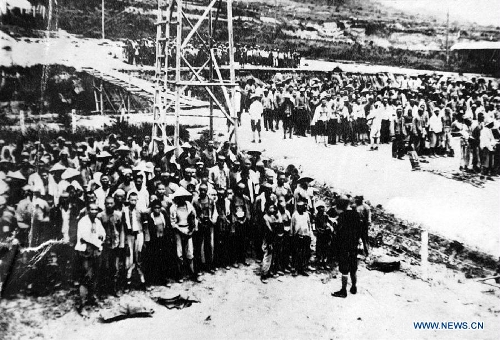
File photo copy shows the rollcall of Chinese forced labors working for Japan to build the Fengman hydropower station in Jilin of northeast China after the region was illegally occupied by Japanese invaders in 1931. Japan invaded northeast China in 1931 and conducted a full-scale invasion in 1937. By the end of World War II, millions of Chinese forced laborers had been enslaved by Japanese invaders to toil under harsh conditions at mines and factories in northeast China and Japan. Those laborers were under close watch and suffered inhumane treatment. Many of them died from malnutrition, illness, physical abuse and plain murder. (Xinhua)
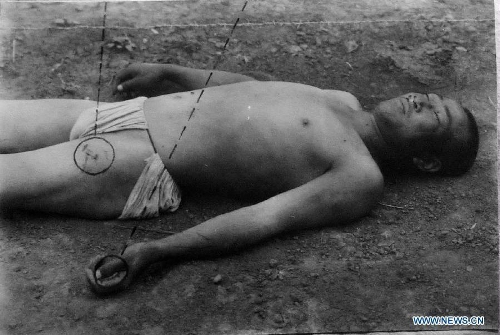
File photo copy taken on Jan. 10, 2014 from the provincial archives of Jilin shows a Chinese forced labor killed by electrocution during Japanese occupation of northeast China. Japan invaded northeast China in 1931 and conducted a full-scale invasion in 1937. By the end of World War II, millions of Chinese forced laborers had been enslaved by Japanese invaders to toil under harsh conditions at mines and factories in northeast China and Japan. Those laborers were under close watch and suffered inhumane treatment. Many of them died from malnutrition, illness, physical abuse and plain murder. (Xinhua/Wang Haofei)
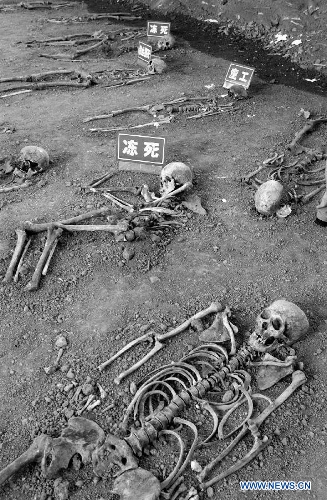
File photo copy taken on July 9, 2005 shows remains of Chinese forced labors in northeast China's Jilin, who worked for Japan to build the Fengman hydropower station after the region was illegally occupied by Japanese invaders in 1931. Japan invaded northeast China in 1931 and conducted a full-scale invasion in 1937. By the end of World War II, millions of Chinese forced laborers had been enslaved by Japanese invaders to toil under harsh conditions at mines and factories in northeast China and Japan. Those laborers were under close watch and suffered inhumane treatment. Many of them died from malnutrition, illness, physical abuse and plain murder. (Xinhua/Jiang Lin)
